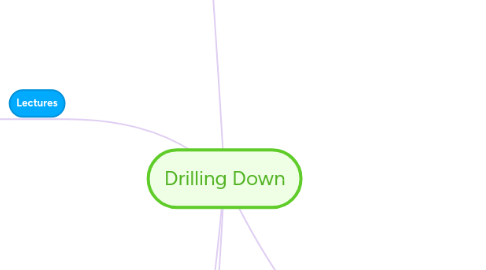
1. Presentation
1.1. Audience
1.1.1. Professional
1.1.1.1. Conference
1.1.1.2. Seminar
1.1.2. School
1.1.2.1. College
1.1.2.2. High School
1.1.3. Entertainment
1.1.3.1. Concert
1.1.3.2. Theater
1.2. How long should a presentation be?
1.3. Size of Audience/Room
1.3.1. <100
1.3.2. 101-200
1.3.3. 201-500
1.3.4. >500
1.4. Time Limit
1.4.1. <30 min
1.4.2. 30 min - 1 hour
1.4.3. >1 hour
2. Lectures
2.1. Preparation
2.1.1. Is there...
2.1.1.1. New material (concepts/terminology)
2.1.1.2. Preparatory reading
2.1.2. How does the lecture...
2.1.2.1. Relate to stuff you already know
2.1.2.2. Fit in with the course as a whole
2.1.3. Can you...
2.1.3.1. Print Handouts
2.1.3.2. Record the lecture (ask permission in advance)
2.2. In the lecture
2.2.1. Concentrate
2.2.1.1. Loss of Focus
2.2.1.2. Distractions
2.2.2. Participate
2.2.2.1. Active Listening
2.2.2.2. Questioning
2.2.3. Look out For
2.2.3.1. "Cue" Words
2.2.3.2. Key Points
2.2.4. Take Notes
2.2.4.1. Structured
2.2.4.2. Well Laid Out
2.2.4.3. Brief
2.3. After the Lecture
2.3.1. Discuss Content
2.3.1.1. Other Students
2.3.1.2. Lecturer
2.3.1.3. In Tutorials
2.3.2. Revise and Correct Notes
2.3.3. Use Recording if Available
2.3.4. File Notes Neatly
2.4. Notetaking Techniques
2.4.1. Use your own words
2.4.2. Use abbrevations
2.4.3. Be selective
2.4.4. Index cards
2.4.5. Highlighting
2.4.6. Mind maps
3. Mapping
3.1. students don't understand concepts in biology class
3.1.1. concept maps
3.1.1.1. concept maps visually represent information and relationships between concepts
3.1.1.2. Map starts with a main topic
3.1.1.3. concepts are managed into subconcepts for each group and category
3.1.1.4. Arrows are used to show relationships between concepts
3.1.1.5. Learning happens while making the map
3.1.1.6. new information can be added so map represents ongoing class materials
3.1.1.7. can provide a teacher with Ms. Ellington with feedback of students' misconceptions and the development of students' understanding over time.
4. Timelines
4.1. Help students make connections between the present and the past
4.1.1. Visually appealling
4.1.1.1. Online interactive timelines support visually rich displays of information -text,, images, hyperlinks - using spatial categories, and color schemes to convey meaning.
4.1.2. Chronological way
4.1.2.1. Timelines tools can help students organize various pieces of information in chronological order.
4.1.3. Learning the easy way
4.1.3.1. Timelines enable students to easily comprehend and internalize information, chronological sequences, and dates. Timelines enable to participate actively and in building new building experiences.
5. Discussions
5.1. Contents
5.1.1. Create Guidelines for Developing Discussion Questions
5.1.1.1. Frame the question as open-ended. Begin questions with how, what or why
5.1.1.2. Create questions that will elicit more than one answer or solution
5.1.1.3. Ask students to provide support for their response with examples/references, e.g. personal experience, course materials or outside sources.
5.1.1.4. Create questions that encourage students to voice their opinion, perspective or personal experience
5.2. Students
5.2.1. Aren’t clear on the expectations: whereto post, what post should include(length, content,l etc.) and/or deadline for posting
5.2.1.1. Dedicate web page/section withincourse site to online discussionswith: guidelines, due dates, linksto how-to instructions, etiquette
5.2.1.2. Include example of an ideal post
5.2.1.3. Post message at beginning of course highlighting key points and why discussions are important
5.2.1.4. Include due dates on course calendar or display on course site
5.2.2. Poor discussion etiquette
5.2.2.1. Include ‘do and don’t’ guidelines for behaving in discussion forums
5.2.2.2. Moderate discussion forums
5.2.2.3. Remind students during course if necessary the etiquette guidelines
5.3. Teachers
5.3.1. Use online discussion to benefit students, not you
5.3.1.1. Prepare students to participate in an online discussion
5.3.1.2. Build in motivation for students to participate.
5.3.1.3. Teach students how to use the technology.
5.3.1.4. Bring the forum into the classroom. The more connected the forum is to the work you are doing in the classroom, the more likely students are to participate in and read the comments on the forum
